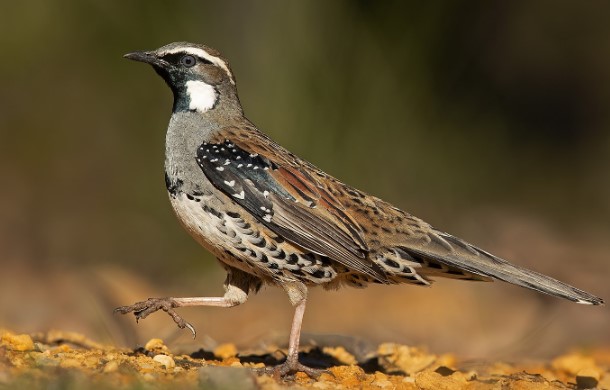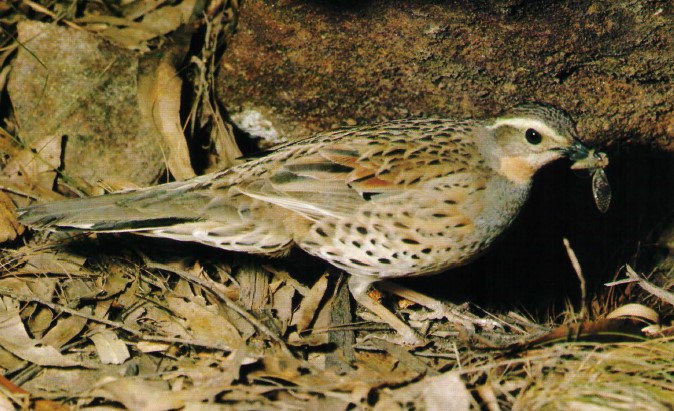The spotted quail-thrush (Cinclosoma punctatum) is the largest and plumpest quail-thrush. This is the only one of its groups to live in temperate sclerophyll forests. The size of the spotted quail-thrush is 270–280 mm long. Spotted Quail-thrush calls with repeated, long-drawn, high-pitched whistles, both in contact and alarm; harsh guttural call. The spotted quail-thrush song is about 8–10 soft, repeated penetrating double whistles, a second higher than the first. Loudness varies; the ventriloquial effect is produced by a bird moving its head from side to side.
The species lives mostly in hilly countries and ridges running off high plateaus in southeastern Australia, where it inhabits dry sclerophyll forests with a clear understory but is heavily littered with debris. It is widespread in small numbers there, but an outlying population in the Mt. Lofty Ranges, SA, has become scarce since European settlement. The species is now on the verge of extinction. This bird is also known as the spotted babbling-thrush and the spotted ground-bird.
Read More: Painted buttonquail (Turnix varius)

On the forest floor, the birds feed alone or in pairs. As they travel, pairs or family groups stay in touch with brief bursts of thin, high-pitched whistles. With bodies crouched, they run along an erratic path, meandering here and there, picking up food insects, seeds, and small lizards as they move. Large caterpillars and beetles are pinned to the ground with one foot and pulled apart; grasshoppers are also dismembered.
Through their camouflaging color pattern, quail thrushes are wary and elusive, and blend in effortlessly with the landscape. When flushed, they fly low through the forest in rocketing undulations that rarely carry them more than 50 meters. Each undulation shows white tips on the tails, which are partially fanned.
Spotted quail-thrush is a ground nester. The male defends a breeding territory by singing from low, bare perches in trees positioned 8–10 meters above the ground; his series of double whistles is unique among quail thrushes. In courtship and threat, the birds fan the tail, flare their body feathers, and lift their wings, only spreading the wings out when defending young. The female alone builds the nest, incubates, and broods the sooty-downed nestlings, though she sometimes leaves the eggs for long periods. On return, she often sits by her mate. Once the young hatch, the male shares in the duties of feeding them a variety of insects, small lizards, and seeds.
Read More: Red-backed Button-quail (Turnix maculosa)
The male bird’s crown and back are brown-grey, liberally arrowed with black. Eyebrows are white. Wing coverts are dark brown with small white spots; wing quills are grey, and the innermost quills are chestnut and black. Tail feathers are dusky grey and, except the central two, broadly tipped white. Throat and lores black; broad white patch on throat sides. The sides of the face, neck, and breast are mid-grey with a narrow dark band on the lower breast; the belly is white. Flanks buff, spotted dark; undertrials buff-white with dark spots. Eyes are blue-grey to lilac. The bill is black. Legs are pale pink.
The female is duller, with no black areas except spotting. Brow buff-white; patches on throat pale orange; throat off-white tinged buff,· lores grey. The wings are grey-brown with off-white tips. Tasmanian females have a black band on their lower breasts. The immature upper parts are brown-flecked black; the eyebrows are buff. The throat is pale buff with dusky fringes and feathers. Moreover, the breast and flanks are tinged buff and heavily speckled black. The belly is white; the eyes and bill are brown. Immature males resemble females, while in the first winter, they resemble adult males.
Nesting and breeding occur in July–February, mainly in August-December. Nest in a depression in the ground, loosely lined with grass, leaves, and bark to form a cup; placed near the base of a tree, stump, boulder, or grass tuft.
Spotted Quail-thrush lays two eggs, occasionally three; white, spotted, and blotched with dusky brown and deep purple. The eggs are long-oval in shape, about 32 x 24 mm. The female bird is responsible for incubation. Young fly in 19–20 days. The spotted quail-thrush belongs to the family Cinclosomatidae.
As far as distribution is concerned, Spotted Quail-thrush is found in dry, and sometimes wet, sclerophyll forests. Three isolated populations: Mt Lofty Ranges, SA; southeastern mainland; Tasmania. There are two races, one in Tasmania and the other on the mainland.
Read More: Stubble Quail (Coturnix pectoralis)







